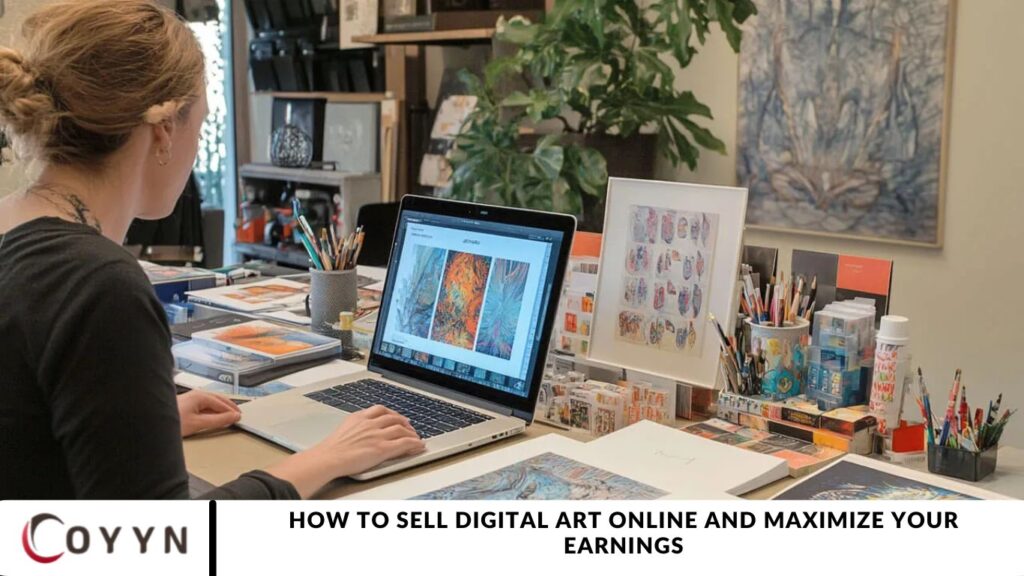Are you a skilled digital artist eager to transform your creativity into a profitable business? Selling digital art online offers a powerful opportunity to reach a global audience and generate consistent income from anywhere. In this COYYN article, we’ll guide you through the best strategies to successfully market and sell your digital artwork, maximize your earnings, and build a sustainable online art business.
Benefits of Selling Digital Art Online
Selling your digital art online offers numerous advantages. Most importantly, it provides a platform to showcase your work to a worldwide audience. Unlike traditional galleries with physical limitations, the Internet enables you to connect with potential buyers across the globe, significantly expanding your customer reach.
Moreover, selling digital art online removes the hassle of maintaining physical inventory and eliminates shipping costs. Since digital files can be stored and delivered electronically, you save both time and expenses. Additionally, the online art marketplace operates 24/7, allowing you to earn passive income as your artwork sells around the clock.
Popular Platforms for Selling Digital Art
There are numerous platforms for selling digital art, each with its advantages and drawbacks. The best choice depends on your art style, target audience, and business goals. Here are some of the most popular options:
- Etsy: Ideal for selling digital art prints and other creative goods, Etsy boasts a large, active user base and an easy shop setup. However, it takes a commission on sales, and competition is high.
- Saatchi Art: A high-end online art gallery catering to collectors, Saatchi Art is an excellent choice for selling original digital artworks or limited edition prints. However, artists must pass a jury selection process to join.
- Society6: A print-on-demand platform that allows you to sell your art on products like t-shirts, mugs, and phone cases. While it offers broad exposure, Society6 takes a cut of each sale, and pricing control is limited.
- Creative Market: Designed for digital assets like fonts, templates, and illustrations, this platform is perfect for artists creating resources for other creatives. However, sellers must go through a curation process.
- NFT Marketplaces (Foundation, OpenSea, KnownOrigin): These platforms specialize in selling digital art as NFTs (non-fungible tokens), offering opportunities for new revenue streams. While NFTs can be lucrative, the market is still evolving and carries some risks.
How to Choose the Right Platform for Your Digital Art
- Type of Art: Some platforms cater specifically to specific styles or formats, so choose one that aligns with your work.
- Target Audience: Identify who you want to reach and ensure the platform’s user base matches your ideal buyers.
- Business Goals: Are you focused on maximizing earnings, building a following, or both? Different platforms support different objectives.
- Fees & Commissions: Understand the cost structure, including listing fees and commission percentages, to ensure profitability.
- Competition: Consider how many artists are selling similar work and whether you can stand out.
Additionally, evaluate:
- Platform Features: Look for tools that enhance your selling experience, such as customization options, analytics, and marketing support.
- Community & Support: A strong artist community and customer support can provide networking opportunities and assistance as you grow.
Setting Up Your Online Shop for Selling Digital Art
Once you’ve selected the right platform, it’s time to set up your online shop and prepare your digital art for sale. Follow these essential steps to ensure a professional and appealing presentation:
- Optimize Your Artwork for Online Display: Ensure your digital art looks sharp and vibrant on screens by optimizing resolution, color accuracy, and file size.
- Choose the Right File Formats: Select formats that maintain quality and are compatible with the platform. Standard options include JPEG and PNG for images and PDF for high-resolution prints.
- Write Compelling Product Descriptions: Craft engaging descriptions that highlight your art’s unique features, inspiration, and any special techniques or materials used.
- Offer Flexible Pricing Options: Provide various purchasing choices, such as digital downloads, physical prints, or limited edition pieces, to appeal to different buyer preferences and budgets.
Pricing Your Digital Art
Pricing your digital art can be challenging, but considering these key factors can help you determine a fair and competitive price:
- Time and Effort: Factor in the hours spent creating your artwork, its complexity, and the skill level required. Your expertise and effort should be reflected in the price.
- Market Research: Analyze the pricing of similar digital art pieces on your chosen platform. Understanding the market helps you position yourself competitively without undervaluing your work.
- Perceived Value: Consider how buyers perceive your art. Your reputation, past sales, and demand for your style can justify higher pricing.
- Flexibility and Experimentation: Pricing is not set in stone. Test different price points, track buyer responses, and adjust accordingly to maximize sales and profitability.
Promoting and Marketing Your Digital Art
Pricing your digital art can be challenging, but considering these key factors can help you determine a fair and competitive price:
- Time and Effort: Factor in the hours spent creating your artwork, its complexity, and the skill level required. Your expertise and effort should be reflected in the price.
- Market Research: Analyze the pricing of similar digital art pieces on your chosen platform. Understanding the market helps you position yourself competitively without undervaluing your work.
- Perceived Value: Consider how buyers perceive your art. Your reputation, past sales, and demand for your style can justify higher pricing.
- Flexibility and Experimentation: Pricing is not set in stone. Test different price points, track buyer responses, and adjust accordingly to maximize sales and profitability.
Building a Brand as a Digital Artist
Building a strong brand as a digital artist is essential for long-term success. Here’s how to establish a memorable and impactful identity:
- Define Your Style and Niche: Identify what makes your art unique and specialize in a specific niche. This helps differentiate you from other artists and attract a dedicated audience.
- Develop a Cohesive Visual Identity: Create a distinctive logo, color palette, and branding elements that reflect your artistic style. Consistency across your website, social media, and online store strengthens brand recognition.
- Share Your Story: Connect with your audience by sharing your artistic journey, inspirations, and creative process. Storytelling adds depth to your work and helps build a loyal following.
- Engage and Provide Excellent Customer Service: Build relationships with your audience by responding to inquiries, interacting on social media, and delivering a great customer experience. Positive engagement fosters trust and encourages repeat buyers.
Selling Limited Edition Prints and Merchandise
Expanding your product offerings beyond digital downloads can significantly boost your revenue potential. Consider adding limited edition prints and merchandise featuring your artwork. Here’s how to get started:
- Partner with a Reliable Print-on-Demand Service: Research and choose a trusted provider that handles printing, packaging, and shipping, ensuring high-quality products and a seamless customer experience.
- Design Exclusive Products: Create unique offerings such as art prints, canvases, apparel, or accessories that showcase your work. Limited edition items add a sense of exclusivity and urgency, encouraging buyers to act quickly.
- Promote Your Releases Strategically: Build anticipation by announcing upcoming drops on social media, email newsletters, and your online store. Use countdowns, behind-the-scenes content, and special promotions to generate excitement and drive sales.
Building Your Brand as a Digital Artist

Establishing a distinct artistic style is essential for standing out in the digital art marketplace. Here’s how to define your niche:
- Identify Your Strengths: Focus on the subjects, techniques, and mediums you enjoy most.
- Study Market Trends: Research what styles are in demand while staying true to your creative vision.
- Experiment and Evolve: Continuously refine your style to develop a recognizable artistic identity.
Creating a Strong Visual Identity
Your visual branding should reflect your art style and appeal to your target audience. Key elements include:
- Logo & Branding: Design a professional logo that represents your artistic identity.
- Website & Portfolio: Create an online space to showcase your best work and provide easy access for potential buyers.
- Social Media Aesthetics: Maintain a cohesive look across platforms with consistent colors, fonts, and post styles.
Sharing Your Artistic Journey
Connecting with your audience on a personal level builds trust and engagement. Here’s how:
- Tell Your Story: Share your inspiration, creative process, and personal experiences behind each artwork.
- Engage with Followers: Respond to comments, ask for feedback, and interact with your community.
- Behind-the-Scenes Content: Show work-in-progress pieces, sketchbook pages, or time-lapse videos to provide insight into your creative process.
Tracking Performance and Scaling Your Business
Tracking your sales and customer behavior is essential for optimizing your digital art business. Here’s how to use analytics effectively:
- Monitor Website & Store Metrics: Use tools like Google Analytics, Etsy Stats, or Shopify Insights to track visitor behavior, sales conversions, and bounce rates.
- Analyze Customer Demographics: Understand who your buyers are (age, location, interests) to tailor marketing efforts.
- Track Best-Selling Products: Identify which artworks or product types generate the most revenue and create similar offerings.
Identifying Trends and Adjusting Strategies Accordingly
Staying ahead of market trends helps you refine your business approach. Consider these strategies:
- Observe Art and Design Trends: Follow social media platforms, industry blogs, and competitor stores to identify emerging trends in digital art.
- Test Different Pricing & Promotions: Experiment with discounts, limited-time offers, or bundling deals to see what drives more sales.
- Adapt Your Marketing Strategy: If a specific platform or campaign performs well, invest more effort into it while improving underperforming areas.
Expanding to New Platforms and Markets
Diversifying your presence can increase visibility and revenue. Here’s how to expand effectively:
- Sell on Multiple Platforms: If you started on Etsy, consider adding Society6, Creative Market, or NFT marketplaces to reach different audiences.
- Target International Buyers: Offer global shipping or digital downloads to attract buyers worldwide.
- Leverage Social Media & Marketplaces: Utilize Instagram, Pinterest, and TikTok to showcase your art and direct traffic to your store.
Frequently Asked Question
Where can I sell my digital art online?
You can sell digital art on platforms like Etsy, Gumroad, Creative Market, Redbubble, Society6, OpenSea (for NFTs), and your website.
What type of digital art sells best?
Popular categories include illustrations, graphic design elements, stock illustrations, printable wall art, NFTs, and custom commissions.
How do I price my digital art?
Consider factors like complexity, licensing rights, exclusivity, and market demand. Start by researching similar works and gradually adjust prices based on sales.
What’s the best way to market my digital art?
Use social media (Instagram, Pinterest, TikTok, and Twitter), participate in online communities, offer discounts, and collaborate with influencers or other artists.
Do I need to copyright my digital art?
When created, your work is automatically protected under copyright law, but you can register it for additional legal protection.
Conclusion
Selling digital art online offers artists endless opportunities to turn their passion into a profitable business. By choosing the right platform, setting the right pricing strategy, and implementing effective marketing techniques, you can reach a global audience and maximize your earnings.
To succeed, focus on building your brand, engaging with your audience, and continuously improving your craft. Use analytics to track sales, identify trends, and adjust your strategies for long-term growth. Expanding to multiple platforms, offering merchandise, and exploring NFTs can further increase your revenue potential.


